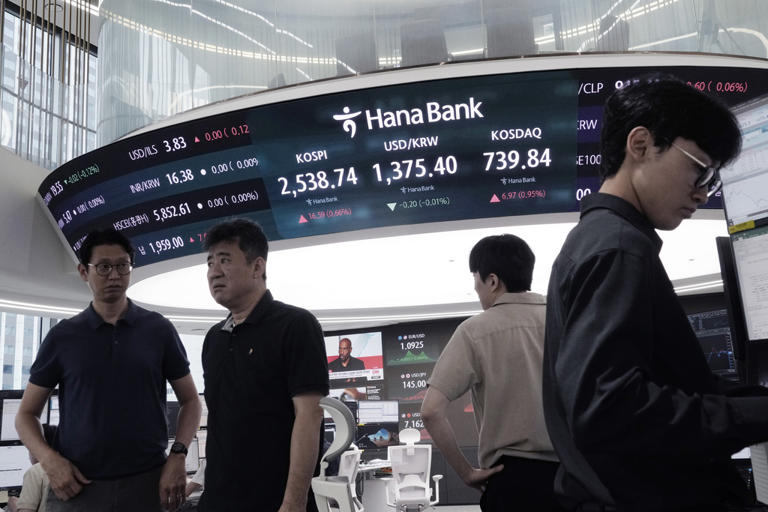On Wednesday, Asian financial markets experienced a notable rebound, reflecting a resurgence in investor confidence after a period of significant volatility. Japan’s benchmark Nikkei 225 index, which had initially shown a decline right after the market opened, reversed course and surged significantly. By midday, the Nikkei 225 had advanced 3.1% to 35,725.58. This upward movement was a dramatic turnaround from the previous day’s sharp losses. On Tuesday, the Nikkei had plunged more than 10%, marking its worst single-day performance since 1987. The steep drop on Monday was attributed to a combination of factors, including concerns about the broader economic impact of the Bank of Japan’s (BOJ) recent policy adjustments.
The recovery in the Nikkei 225 was largely attributed to supportive comments from Shinichi Uchida, a vice governor of the BOJ. Uchida’s remarks provided reassurance to investors, noting that despite the central bank’s recent interest rate hike from 0.1% to 0.25%, the overall monetary policy remains accommodative. He emphasized that even with rising inflation and inflation expectations, the current interest rate is still low in real terms, which implies that the financial conditions are still favorable. Uchida’s comments helped to alleviate concerns about the potential negative impact of higher interest rates on Japan’s economic growth, thus boosting market sentiment.
The BOJ’s interest rate hike had initially triggered a cascade of selling among traders who were adjusting their positions in response to the increased cost of carry trades. These trades, which involve borrowing in a currency with low interest rates to invest in assets with higher yields, are popular among hedge funds and other institutional investors. The rate hike, combined with a strengthening of the yen against the U.S. dollar, had led to significant market volatility. On Wednesday, the yen experienced a rebound, with the dollar rising sharply to 147.53 yen from 144.32 yen the previous day. A weaker yen is generally beneficial for Japan’s export-oriented manufacturers, as it increases their earnings from overseas sales. However, the yen’s surge had previously resulted in gains for the currency late last week.
The broader Asian markets also showed positive movements. In China, the latest economic data revealed a 7% increase in exports for July compared to the same period last year. This growth, although positive, was below the near-10% forecast and represented the slowest growth rate in three months. This slower pace of growth was partially attributed to a low base effect from the previous year, when exports had surged by 8.6% in June. Despite this, major indices in the region showed resilience. Hong Kong’s Hang Seng index, which had initially shown losses, reversed course and climbed 1.6% to 16,917.49. Similarly, the Shanghai Composite index gained 0.4% to 2,879.15. In South Korea, the Kospi index saw a 2.3% increase to 2,579.10, while Taiwan’s benchmark index surged 3.6%. Both South Korean and Taiwanese markets had been among the hardest hit during the previous sell-offs, particularly due to their heavy exposure to technology stocks, which had faced significant losses in recent weeks.
In Australia, the S&P/ASX 200 index also experienced an uplift, rising 0.8% to 7,738.20. This was part of a broader positive trend seen in major global indices. On Tuesday, the U.S. stock markets also showed signs of recovery after a challenging period. The S&P 500, which had been on a downward streak, climbed 1% to end the day at 5,240.03. This increase marked a break in a three-day losing streak, during which the index had fallen by more than 6%. The Dow Jones Industrial Average rose by 294.39 points, or 0.8%, to 38,997.66, while the Nasdaq composite gained 166.77 points, or 1%, reaching 16,366.85. The recovery in U.S. stocks was broad-based, affecting both smaller companies, which rely heavily on domestic consumer spending, and large multinational corporations, which are more dependent on the global economy.
Despite growing fears that the U.S. economy might be slowing too rapidly, many economists remain optimistic, forecasting that a recession in the near term is unlikely. The U.S. stock market is still showing positive performance for the year, buoyed by strong advancements in artificial intelligence technology, although there are concerns that this enthusiasm may have led to overvaluation in some cases. The S&P 500 has achieved several all-time highs this year and is up nearly 10% year-to-date, reflecting ongoing investor confidence despite recent volatility.
In the bond market, the yield on the 10-year Treasury note increased to 3.88% from 3.78% late Monday. This rise in yield followed a brief drop below 3.70% on Monday, driven by market fears and speculation that the Federal Reserve might need to convene an emergency meeting to cut rates quickly in response to economic concerns.
In commodity markets, U.S. benchmark crude oil prices edged up by 17 cents to $73.37 per barrel, while Brent crude, the international standard, also gained 17 cents to reach $76.65. Meanwhile, the euro fell slightly to $1.0912 from $1.0928, reflecting ongoing fluctuations in the foreign exchange markets.
Overall, the positive performance across Asian and U.S. markets on Wednesday highlights a rebound from recent instability, driven by supportive monetary policies and renewed investor optimism about economic prospects, despite ongoing global uncertainties.
